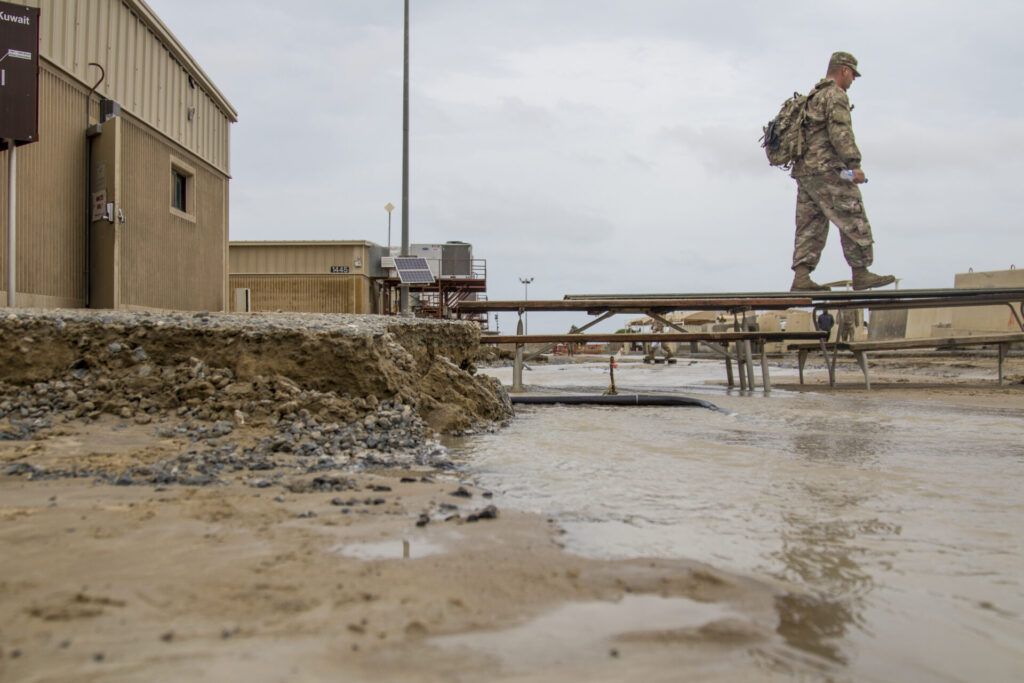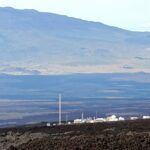Running blind: The silencing and censoring of environmental threats to US national security
By Peter Gleick | May 12, 2025
 A soldier walks across a makeshift bridge of picnic tables to avoid flood waters at Camp Arifjan, Kuwait, in November 2018. Climate change threatens US military bases and operations around the world. (Photo: U.S. Army photo by Staff Sgt. Andrew Carroll)
A soldier walks across a makeshift bridge of picnic tables to avoid flood waters at Camp Arifjan, Kuwait, in November 2018. Climate change threatens US military bases and operations around the world. (Photo: U.S. Army photo by Staff Sgt. Andrew Carroll)
For more than half a century, US intelligence agencies and the armed forces have analyzed threats to national security from a range of environmental angles, including dependence on fossil fuels, competition for scarce water resources and strategic minerals, and especially human-caused climate change. These reports have been produced under presidential administrations across the political spectrum.
Hundreds of assessments have come from, among others, White House National Security Strategy reports, Department of Defense Quadrennial Defense reviews, and studies from every branch of the military, all the war colleges, and the Office of the Director of National Intelligence (ODNI). Their consistent conclusions: Environmental factors pose direct, indirect, and accelerating threats to US forces, operations, bases, and national security interests.
Immediately after the inauguration of President Donald Trump in January 2025, his administration began purging these reports from the public record: removing environmental security studies from government websites or disabling those pages, cutting funding for environmental security studies, and requiring military and intelligence communities to suppress and censor references to climate change. Trump also rescinded Biden’s executive order 14008 that said, “climate considerations shall be an essential element of United States foreign policy and national security.” This censorship was not limited to military and intelligence work; the administration ordered other federal agencies to “archive or unpublish” materials related to climate change as well.
These actions will not reduce the actual risk that environmental problems pose for national security or the military—the physical reality of those threats will be unchanged. Instead, they will blind the country to environmental instability and real-world conflict risks that jeopardize our military and national security.
Awareness of environmental security threats goes back to the middle of the last century. In November 1965, President Johnson’s Science Advisory Committee issued a report warning about the growing impacts of environmental pollution, including the threat of catastrophic climate impacts from melting of ice caps, sea-level rise, and rising temperatures. In September 1969, White House advisor Daniel Patrick Moynihan wrote a memo to John Ehrlichman, assistant to President Nixon, highlighting those conclusions and urging the administration and NATO get involved with the growing risk to the United States of “the carbon dioxide problem.”
A year later, the Rand Corporation launched a program on “climate modification and national security” saying “the U.S. might be harmed either inadvertently or maliciously by changes in the climate.” In December 1974, Secretary of State and National Security Advisor Henry Kissinger issued National Security Study Memorandum NSSM200 suggesting “a major research effort to address the growing problems of water supply, ecological damage, and adverse climate” and their threat to “world economic well-being and political stability.”
The 1990 White House National Security Strategy, required by Congress, explicitly acknowledged the growing risk of emissions from fossil fuels. That same year the U.S. Naval War College issued a report “Global Climate Change: Implications for the United States,” which said:
Naval operations in the coming half century may be drastically affected by the impact of global climate change. For the Navy to be fully prepared for operations in this future climate environment, resources of both mind and money must be committed to the problem.
President Bush’s 1991 National Security Strategy explicitly called out climate change as a threat already contributing to political conflict:
Global environmental concerns include such diverse but interrelated issues as stratospheric ozone depletion, climate change, food security, water supply, deforestation, biodiversity and treatment of wastes. A common ingredient in each is that they respect no international boundaries. The stress from these environmental challenges is already contributing to political conflict.
My own work in this area extends back to 1989, when I published a research paper on the implications of global climatic changes for international security and an analysis of environmental security in the Bulletin in 1991. In May 2006, I testified on this issue to a congressional subcommittee on national security, emerging threats, and international relations.
The recognition of environmental security threats has only intensified in subsequent decades in hundreds of unclassified assessments and government statements, focused in two key areas: the risk that these factors will lead to (1) “widespread political instability and the likelihood of failed states;” and (2) the strategic implications for “military capability,” bases, and operations, as the U.S. Joint Forces Command concluded in 2007. That same year, the Department of the Navy, the Marine Corps, and the Coast Guard published their joint concerns about how climate change is reshaping Arctic strategic issues.
In the 2018 National Defense Authorization Act (HR2810), Congress noted the testimony of Secretary of Defense James Mattis:
I agree that the effects of a changing climate—such as increased maritime access to the Arctic, rising sea levels, desertification, among others—impact our security situation.
and the testimony of Former Chief of Staff of the U.S. Army Gordon Sullivan:
Climate change is a national security issue. We found that climate instability will lead to instability in geopolitics and impact American military operations around the world.
This emphasis continued through the Biden Administration as well and in 2023, the Annual Threat Assessment from the Office of the Director of National Intelligence stated:
In every region of the world, challenges from climate change, demographic trends, human and health security, and economic disruptions caused by energy and food insecurity and technology proliferation will combine and interact in specific and unique ways to trigger events ranging from political instability, to terrorist threats, to mass migration, and potential humanitarian emergencies.
Climate change will increasingly exacerbate risks to U.S. national security interests as the physical impacts increase and geopolitical tensions mount about the global response to the challenge. The increasing physical effects of climate change also are likely to intensify or cause domestic and cross-border geopolitical flashpoints.
But there were also hints that outmoded security concepts like realpolitik, focused on narrow “superpower competition,” together with deep climate denial, were in ascendency. The first Trump administration censored words like “climate change” in government documents and narrowed security concerns to single-nation competition with China, North Korea, and Iran. The Trump White House failed to produce any National Security Strategy in 2018, 2019, or 2020, and the 2018 National Defense Strategy report, which replaced the Quadrennial Defense Assessments, for the first time made no mention of environmental security threats at all. These unprecedented changes were so worrisome that in March 2019, 58 senior military and national security leaders wrote a letter to President Trump to denounce his efforts to “dispute and undermine military and intelligence judgments on the threat posed by climate change.”
All of this is prelude to the recent massive and coordinated effort to purge documents that reference environmental security threats, censor and cut current research and intelligence assessments, and suppress climate science that informs the national security community. In early March 2025, democratic lawmakers sent a letter to Secretary of Defense Hegseth criticizing the Trump Administration efforts saying:
Your threats to cut climate programs at the Department of Defense (DoD) will jeopardize our national security, putting thousands of American lives and billions of American taxpayer dollars at risk.
Very real climate changes are already underway, including accelerating extreme events, an increasingly ice-free Arctic and rising sea levels, disruptions to food supplies, more failed states and environmental refugees, and violence over shared water resources. Wars and armed conflicts are already being triggered, influenced, or worsened by environmental factors.
Denying or turning a blind eye to environmental security threats and hamstringing intelligence agencies will only make the United States weaker and more exposed to dangerous security surprises, military bases and operations more vulnerable, and communities less prepared. Physical reality will always trump political ideology.
Together, we make the world safer.
The Bulletin elevates expert voices above the noise. But as an independent nonprofit organization, our operations depend on the support of readers like you. Help us continue to deliver quality journalism that holds leaders accountable. Your support of our work at any level is important. In return, we promise our coverage will be understandable, influential, vigilant, solution-oriented, and fair-minded. Together we can make a difference.
Keywords: Trump administration, climate and security, climate crisis, national security
Topics: Climate Change















